The Shitty Camera Challenge is the antidote to photography competitions. Instead of celebrating the best that cameras have to offer it celebrates the worst. You have a Leica, forget about joining in. A Hasselblad? No chance. In 2018, Adam James, or PapaShittyCams as he is known on social media, challenged photographers to use thrift store cameras, the crappiest cameras they could find, and the Shitty Camera Challenge was born. Over the years the Challenge has covered all types of photography from film, to digital, to instant, and each time photographers have surprised themselves, and others, with the creativity and images they have produced.
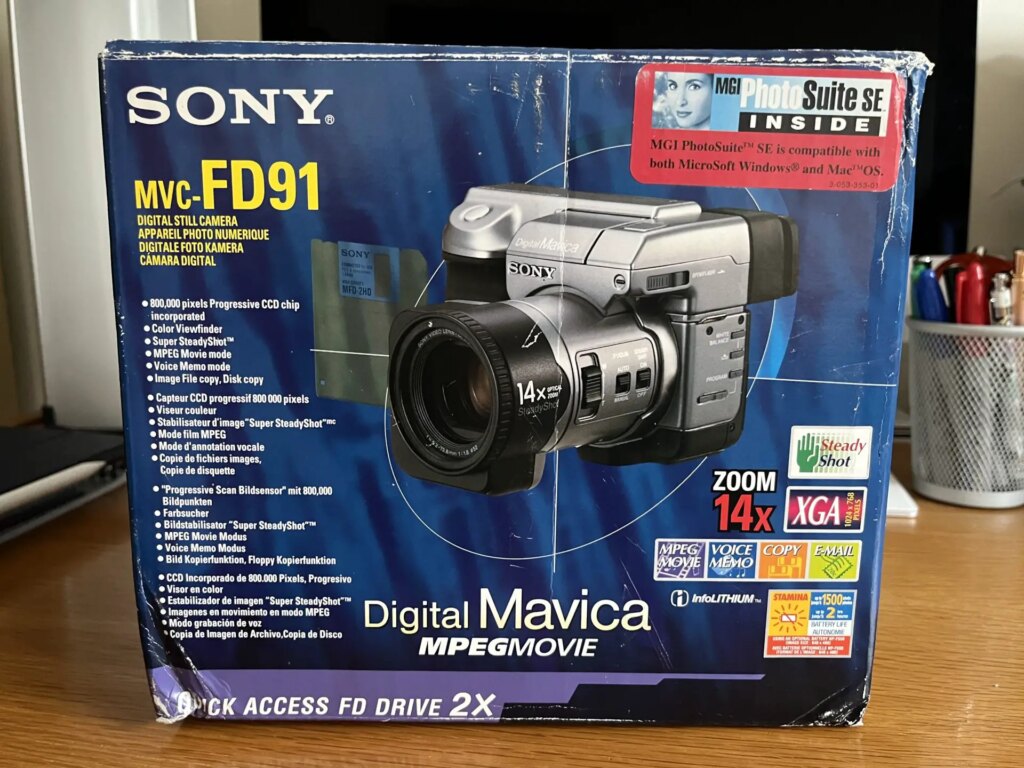
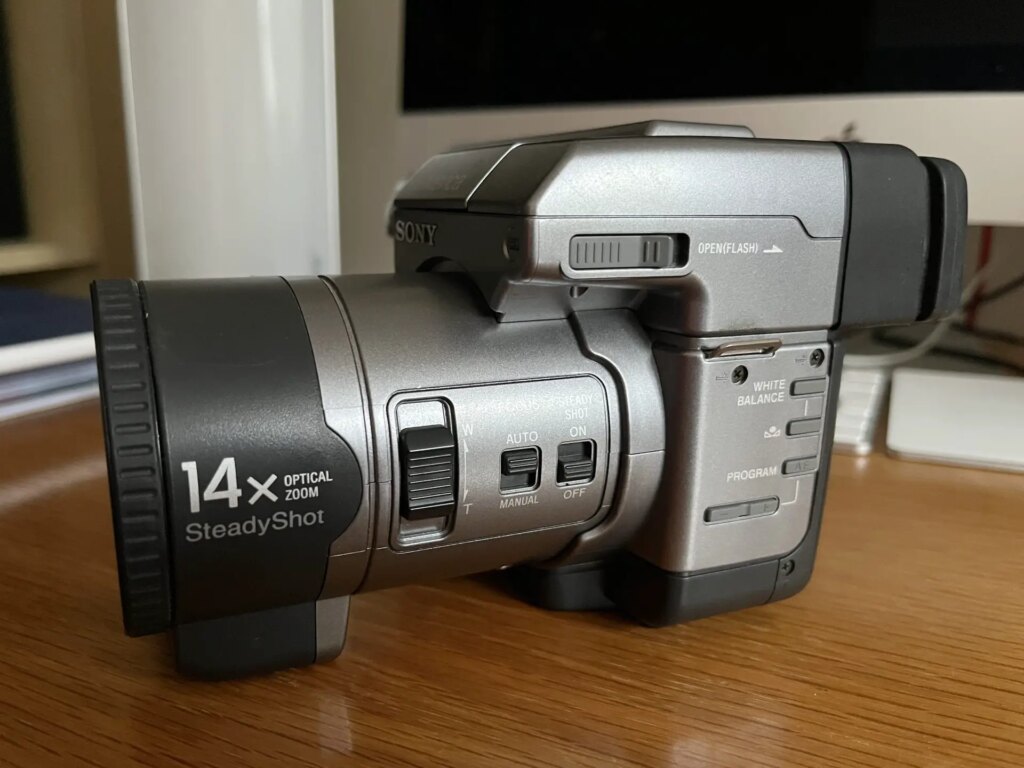
Running from 1 December 2022 to 31 January 2023, the most recent #ShittyCameraChallenge featured cameras from the 1990s. You could pick any camera that you wanted, so long as it was released between January 1990 and December 1999. But which camera would you choose for a 1990s themed photography challenge? For in the 1990s the photographic world was changing. Arguably film cameras were at their peak, but coming out of their shadows were a new breed of device, a digital alternative.
The Sony Mavica camera name actually dates back to 1981, but the FD (floppy disk) digital line began in the late 1990s. The Sony Mavica MVC FD5 to MVC FD91 span the years from 1997-1999, and they used 3.5 inch floppy disks as the recording medium. As a reminder, floppy disks were a way of storing computer files before memory sticks and external hard drives. 1.44 MB of information could be stored on a single disk, and the disks required a floppy disk drive for recording and reading. As a magnetic media they were prone to storage errors when exposed to magnetism, or indeed, sometimes to air or daylight … it’s all very much like a prop from Stranger Things.
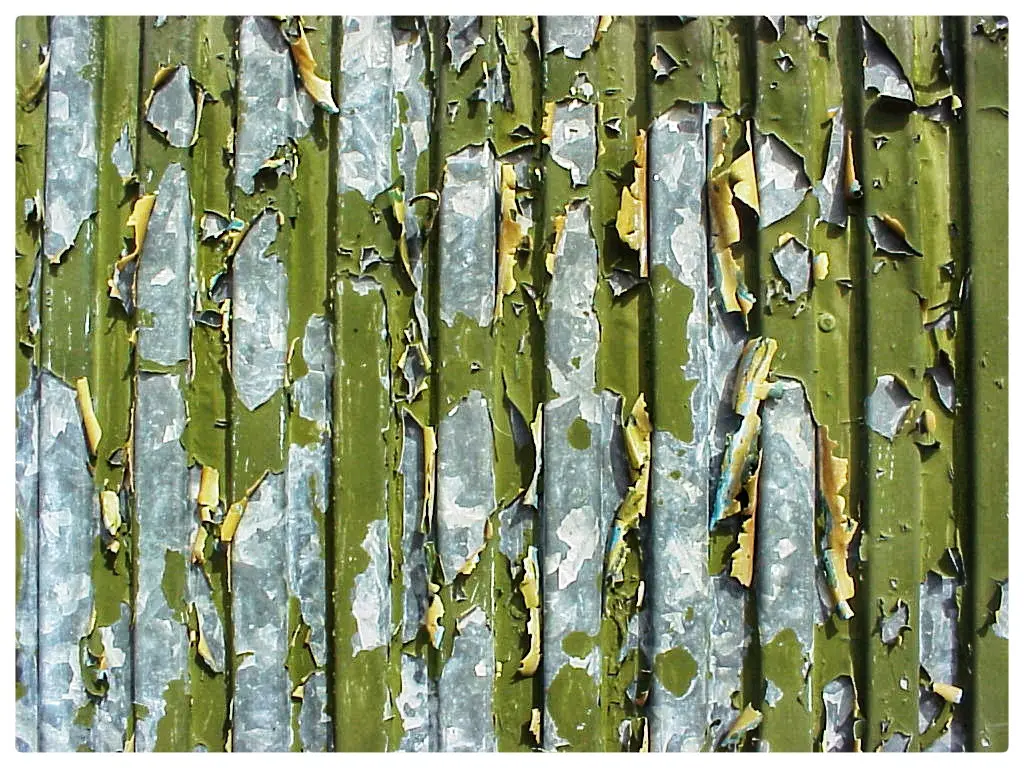
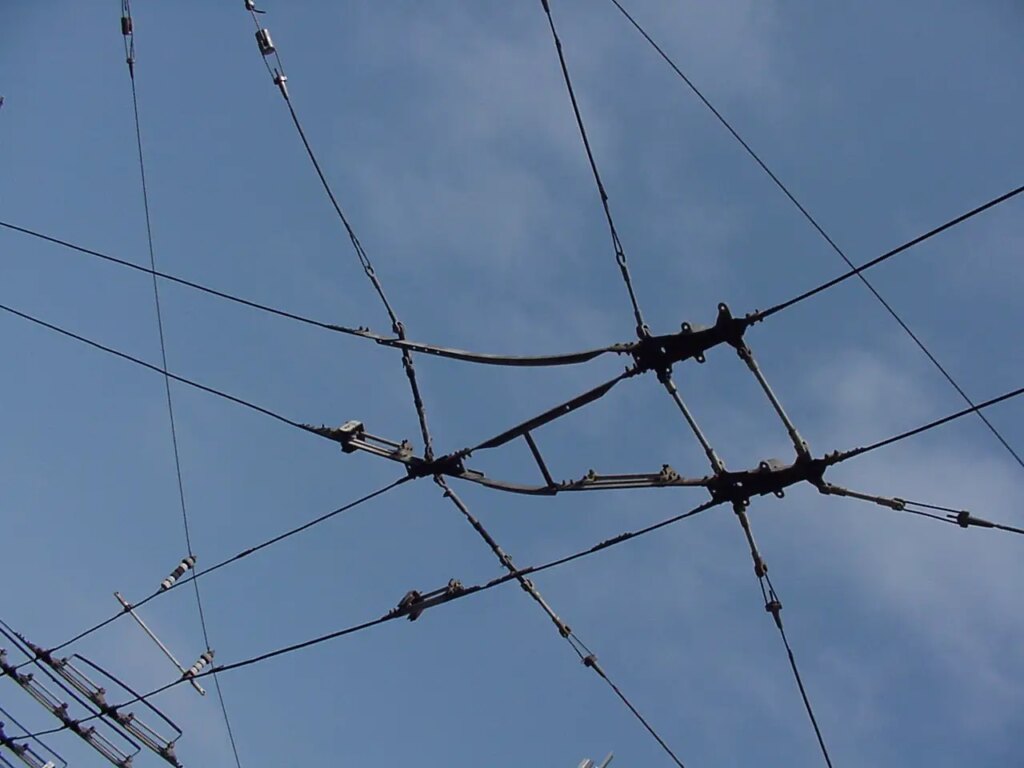
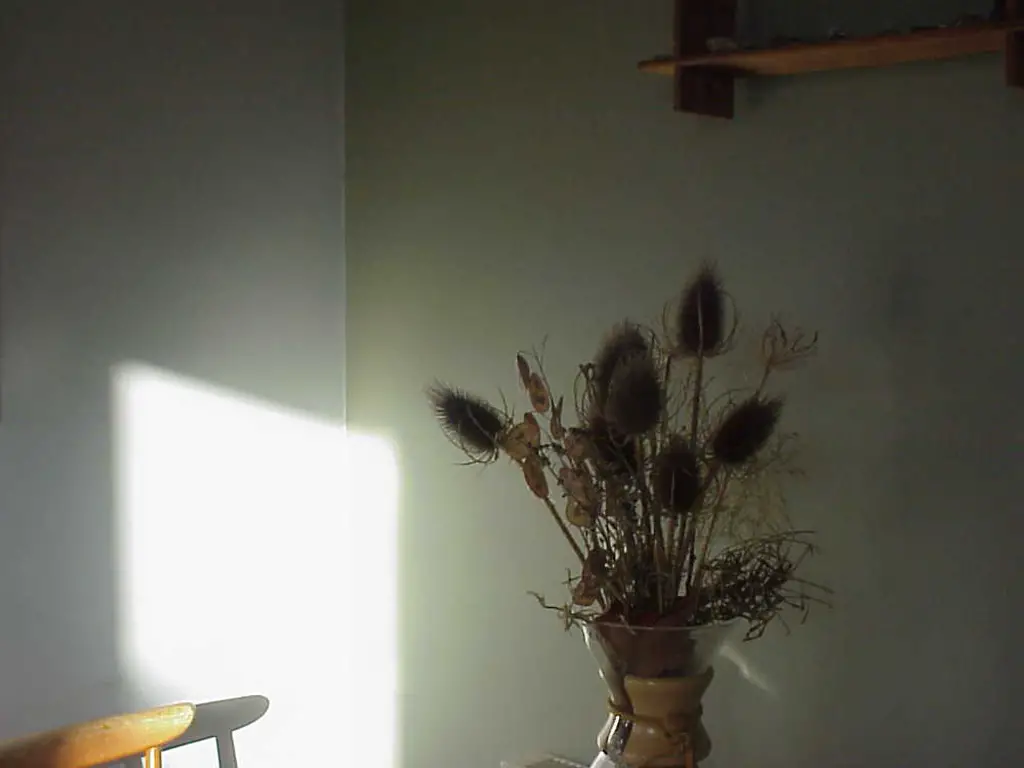
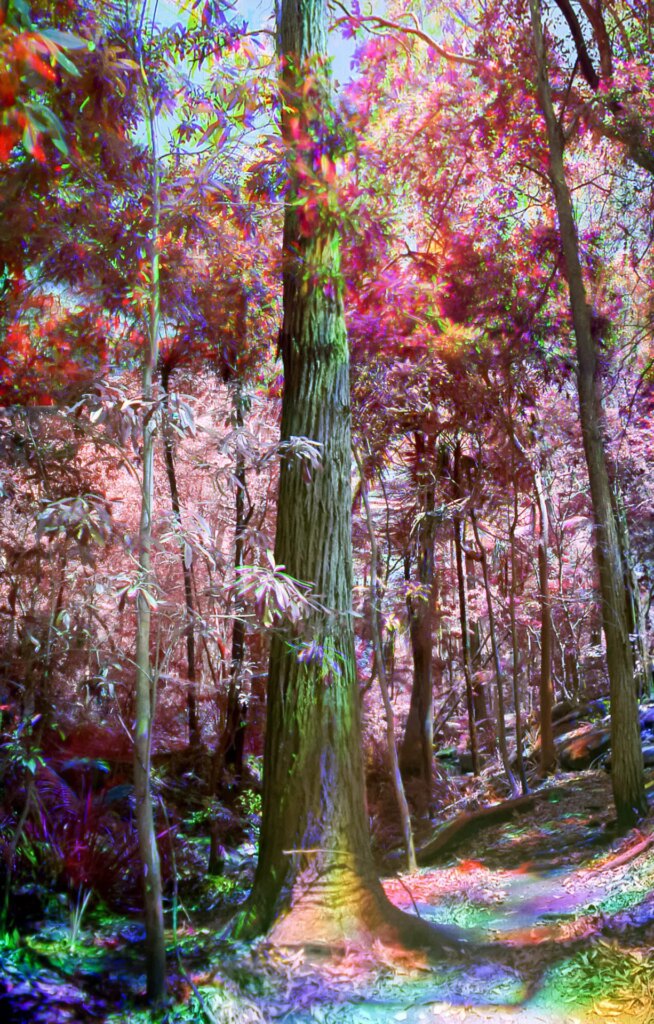
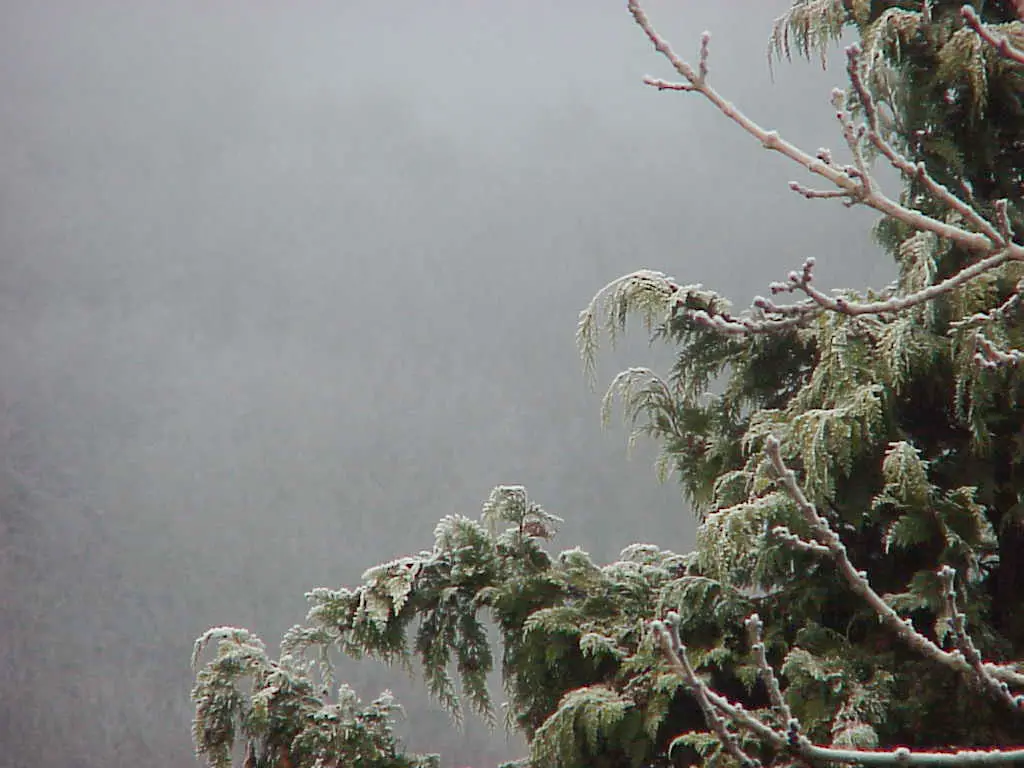
Some of us participating in the #1990sCameraChallenge theme of the #ShittyCameraChallenge chose to use those early digital cameras—strange creatures seemingly caught between analog and digital worlds—the Sony Mavica floppy disk cameras. We called ourselves the Floppy Disk Squad, and these are our stories:
Keith Devereux
I already had two analog cameras in mind that I planned to use for the #1990sCameraChallenge: a Canon Epoca 135 and a Samsung Fino 35s point and shoot. However, the 90s was also the decade when digital cameras started to appear in the consumer market and I really fancied trying something from the dawn of the digital age.
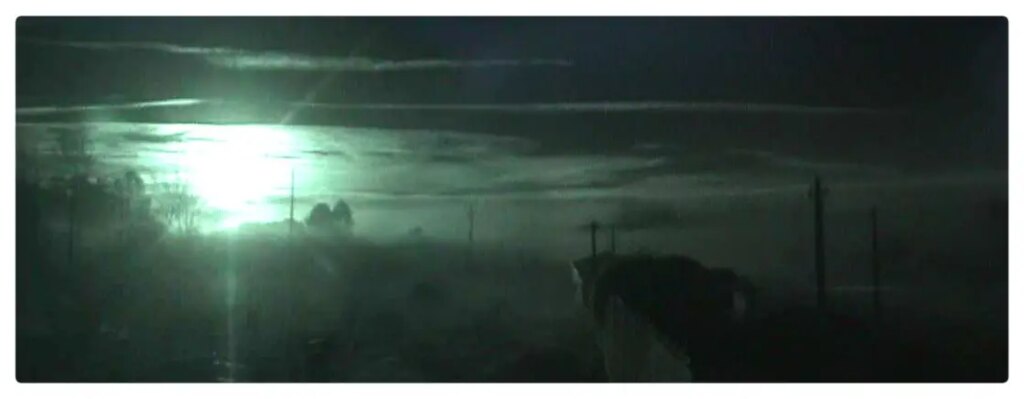
Just like the Nintendo Gameboy, I had wanted a Sony Mavica for quite some time. I’m a bit of a sucker for old digital cameras, and who could resist the idea of using a camera that stores digital images on 3.5-inch floppy disks? The #1990sCameraChallenge seemed the perfect opportunity to take the plunge, so I turned towards OLX, a popular (in Portugal, where I live) classified advert service that has already provided me with a wealth of analogue cameras for very reasonable prices. There were a few Mavicas available, from 20€ to over 100€, so I checked out a couple of the cheaper offers and sent off messages to the sellers.
After several false starts, two Sony Mavicas were soon in my possession; an MVC-FD51 and an MVC-FD81, both from 1998 and both for about 25€. In one of the cameras the battery was completely dead, though in the FD51 the battery has held up quite nicely. I ordered a replacement battery for the FD81, which actually cost more than the camera itself, but I figured that it was a good investment and actually has been wonderful. It was a little challenging to get a working floppy disk drive, but USB floppy drives are available (for about 20€, again) and soon I had all I needed to take and share photos, just like it was the 1990s. I also had a small collection of floppy disks, though not all of them worked, and it was surprising to find some even contained workplace photographs from the early 2000s.
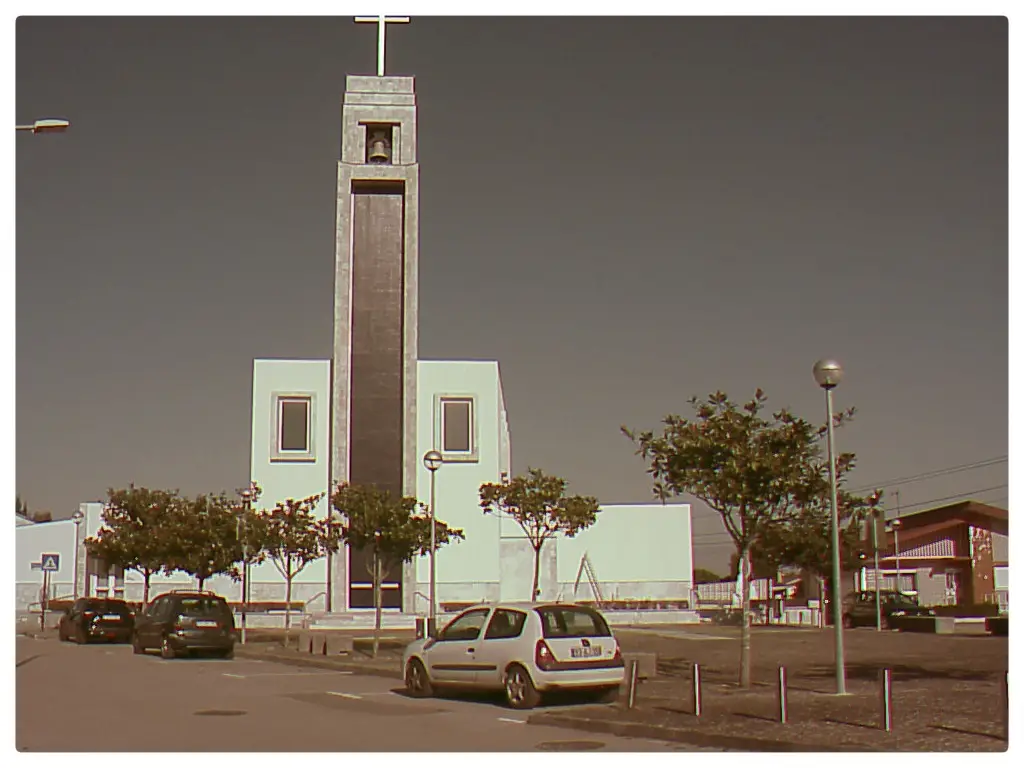
The MVC-FD51 is a basic 0.3MP camera that is of the second generation of Sony Mavicas. It has a fixed focal length lens, a simple slider on the front of the camera for macro mode, a flash, and that’s about it. The floppy disk drive can save images in five seconds (five seconds!), and the FD51 has pre-set optical effects such as black and white, solarisation and sepia. On the back is a small monitor that shows a live image, where you can review your photographs, and a slider switch for taking or reviewing photographs. The floppy disk slips into a drive on the side of the camera behind a nice little door.
I’ve been out with the FD51 several times, both as part of the #1990sCameraChallenge and just for the fun of it, and the MVC-FD51 was always a joy to use, you just point, and shoot. Like modern cameras, a half press on the shutter button sets the focus and exposure and a heavy press on the button will take the photograph. Depending on the images recorded (literally, as the display says ‘recording’ as each file is saved to the floppy disk) up to twenty 640×480 photos can be stored onto a single 3,5-inch floppy disk.

It’s really difficult to get a ‘bad’ photo with the FD-51, although when I tried to make a panorama of a foggy sunrise during the #ShittyCameraChallenge using a variable neutral density filter the resulting image came out looking like something from ‘The Matrix’. Although the images were small, the detail was fine and the colours were natural. One of the images I was very happy with from the FD51 was the five-image panorama of a December sunrise.
The Sony Mavica MVC-FD81 is a whole different ball game compared to the FD51, even though it was released in the same year. It takes photographs with a 1024×768 still image resolution, has a (admittedly pretty decent) zoom lens, and can even take videos, though they can each be no longer than 5 seconds. Aside from a few extra buttons for the back light on the screen, the movie mode and a zoom slider, the FD81 is very similar to the FD51 apart from the increased resolution. The body of the FD81 is slightly larger than the FD51 and it is a little heavier, but I preferred using the FD81 over its predecessor. I didn’t use the flash at all, but I did use the video, from which I made simple GIFs to share on social media.
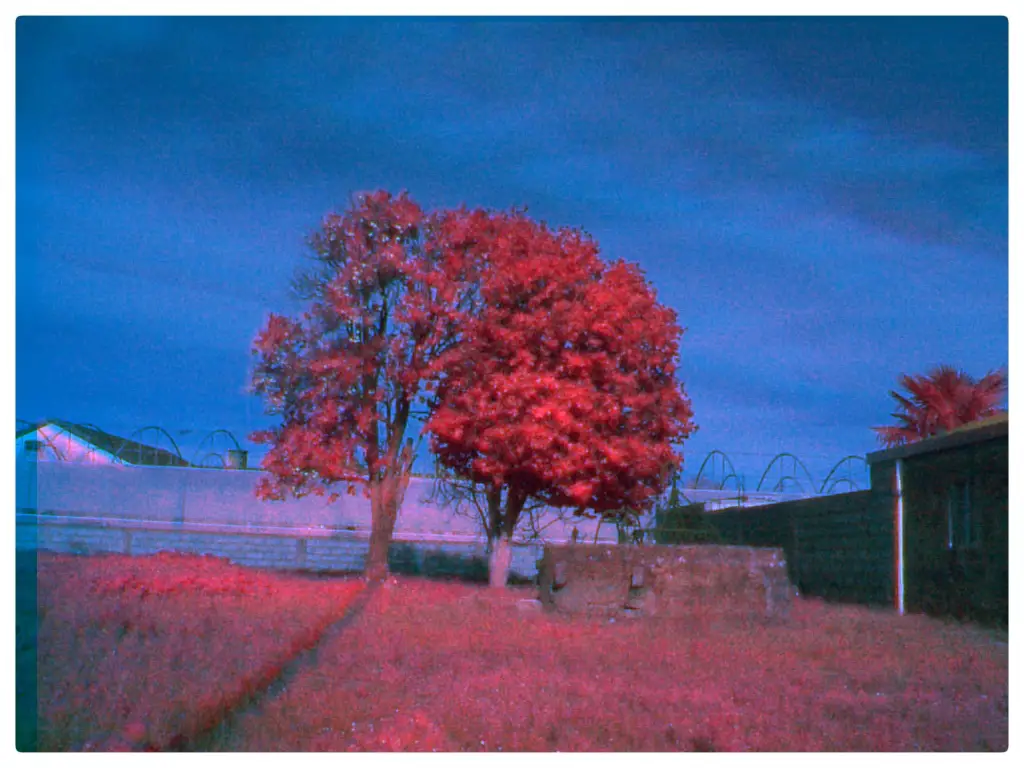
One bonus of the FD81 was its infrared response, and I used its sensitivity to make a Mavica digital aerochrome, although these were no way as good as those made by Bill Thoo. After the #1990sCameraChallenge the fear was that these early digital cameras would be returned to the cupboard, which would certainly be a shame. At one stage I even considered opening up one of the Mavicas and removing the infrared cut filter to make a full-spectrum camera. But I just can’t bear to destroy such a wonderful piece of digital camera history. So until the cameras start to fail naturally I’ll continue to enjoy being a part of the #FloppyDiskSquad.
Karin Lizana
I was looking at old digital cameras for one of the Shitty Camera Challenges when I discovered the Sony Mavica Floppy Disk camera. As a concept, it is fascinating. This camera feels like the bridge between photography’s analog and digital worlds. I used floppy disks when studying engineering for an entirely different purpose, and I was seriously intrigued by the lack of consistency of the medium in a photographic setting. Every person that used floppy disks fairly frequently knows you can’t trust a floppy disk.

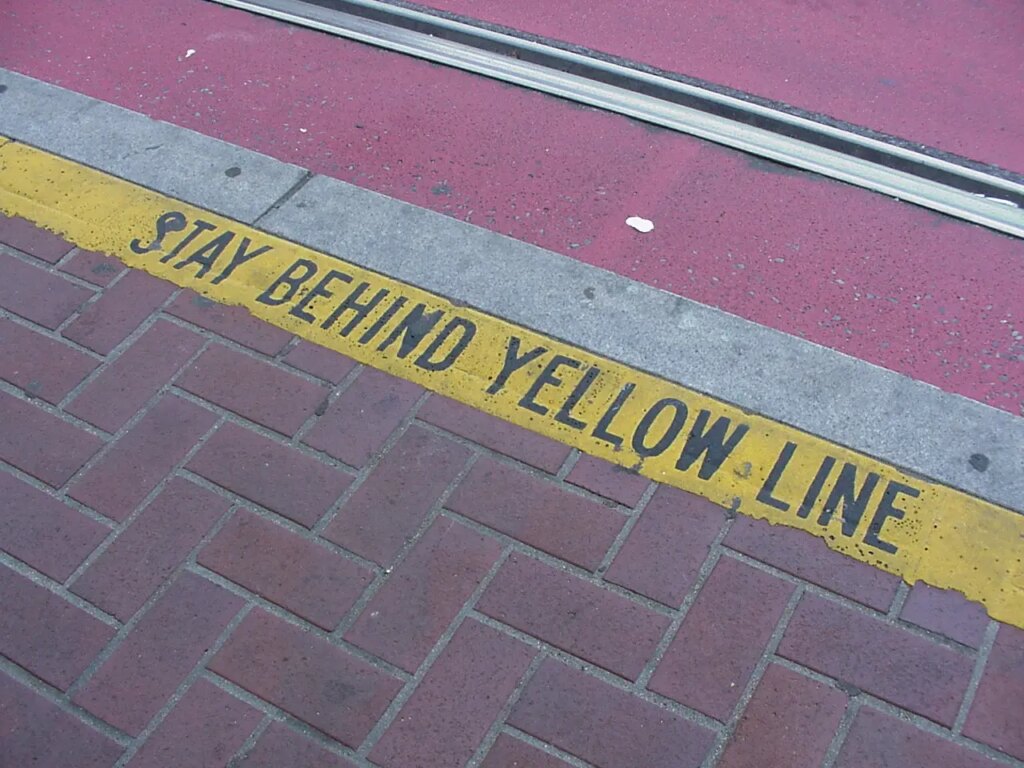
The image quality is what you can expect from a 1.3-megapixel camera. Prints look good up to postcard size; anything bigger is a mess. The over-sharpening from early digital photography is wild, the colors are vibrant, and it can’t handle low-light situations. There is so much digital noise that you wonder if it’s just filling colors randomly when there is insufficient light. Failure to save a photograph and corrupted files are an everyday occurrence, and there is nothing you can do about it. It makes me feel sorry for those early adopters that sold their magnificent film cameras to get into the digital world.

The beauty of this camera has nothing to do with quality or consistency. I use it as a tool to free myself of the burden of photographic perfection. Having little to no control over it makes me try things I wouldn’t do with my film or digital camera, which is the purpose of the Shitty Camera Challenge. Besides, it feels nostalgic to save a digital photograph on a floppy disk.
Joe Holman
A couple of film cameras at the back of the cupboard were eligible for the 1990s camera challenge and I didn’t need any ‘new’ cameras. But there was no harm in looking, was there? Inexplicably, several weird and wonderful old digital cameras ended up on my ‘watch list’. There’s no harm in putting in a little bid, is there, I probably wouldn’t win anyway?
The Sony Mavica FD-81 listed as spares or repairs arrived a few days later. I hoped a battery replacement would bring it back to life. The compatible batteries are of the widely available NP-F variety so I figured it wouldn’t break the bank to take a gamble. On inserting the new battery, a twinkly digital tone told me that thankfully the camera was alive. In the end, a box of disks and a new battery cost more than the camera.

I assumed old digital tech would feel slow and unreliable, but operating the camera felt pretty responsive. Writing to the floppy disk aside, the camera is simple and snappy to use. In some respects it’s a nice balance of mechanics and electronics. The disk eject button has a familiar (to those old enough at least) resistance and the twang as it throws out the disk. The sound as it writes to the disk was a nostalgic treat. With the disk slot being on the side, the general operation is reminiscent of a 4×5 camera. The lack of disk space also means a similarly frugal shot count and shooting approach. I fell into a familiar rhythm, a pouch of six disks at the ready in an easy accessible coat pocket. By 1998 I suppose the disk drive and the optics were mature technologies, and both seem to work well. The sensor department is where things fall down. This is probably to be expected, of course, but I find that crunchy early digital look hard to love. Film brings a sympathetic warmth to memories, but early digital images feel so brutal and unforgiving: a greenish hues in skin tones and the tendency to completely fall apart at the first sign of shade.
Things got much more interesting after some pioneering folks over on Mastodon started posting extraordinary trichrome images made with Mavica cameras. I was inspired to explore this technique but using another of the Mavica’s features, video! Yes, video! The Mavica can shoot Mpeg video to a floppy disk. So I set off with filters and tripod to the local duck pond to make five whole seconds of pure 90s joy. This is when I felt at home with the camera. Process and problem solving are the things that keep me coming back to analogue image making, and for a digital the Mavica feels just about analogue enough. Fixing a broken old lens, taping together a Holga, developing in a sink, jerry-rigging adapters to get a floppy disk drive to work, these are the tactile experiences that add richness to our photographic world. If you like taking the route less travelled, making life harder for yourself and not worrying to much about the outcome, maybe pick up a ‘spares or repairs’ Mavica, hope for the best and join a #ShittyCameraChallenge.
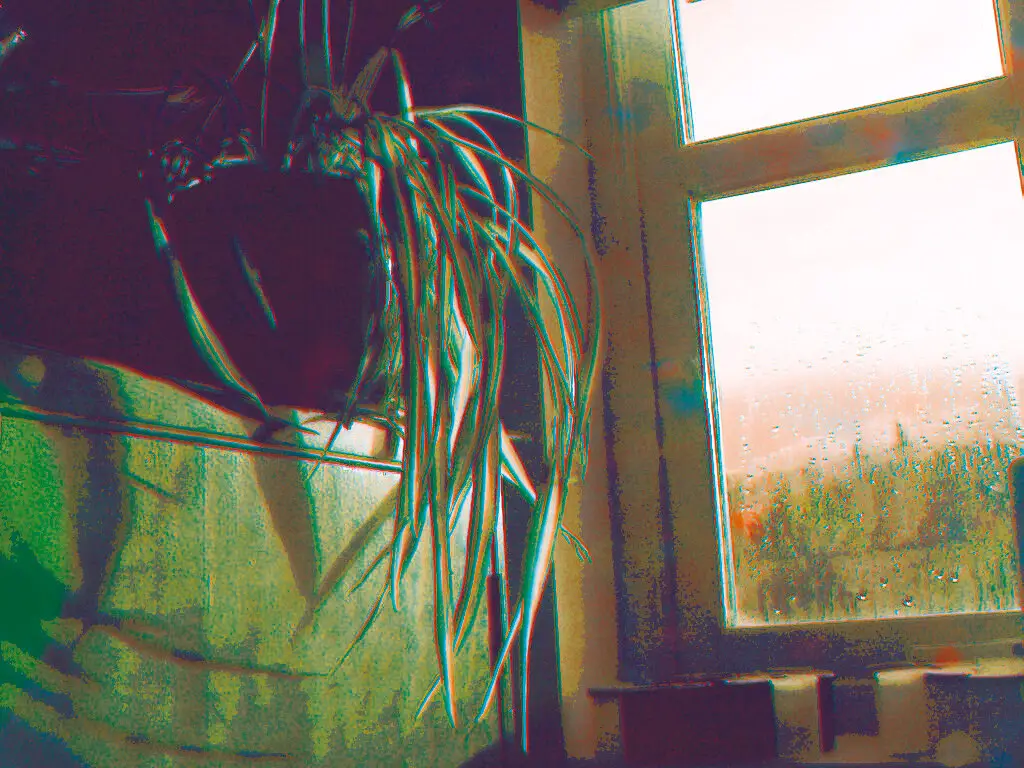
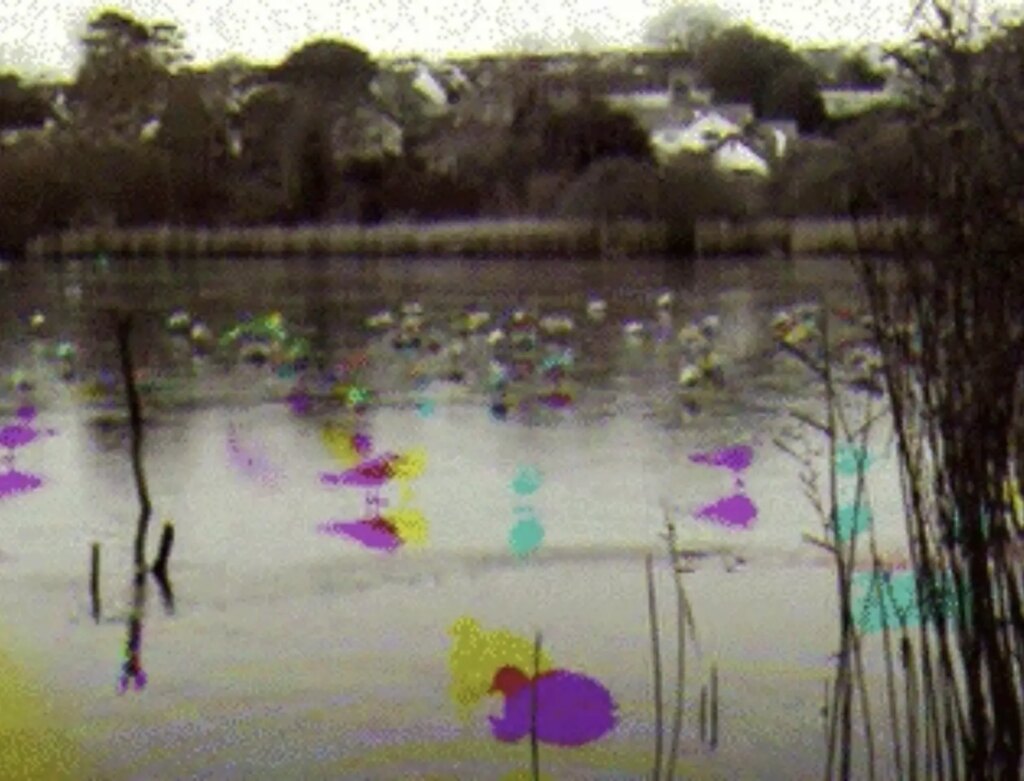
Bill Thoo
I must admit being very influenced by the Floppy Disk Squad in the lead up to the #1990sCameraChallenge. It was no surprise that I found myself with a Sony Mavica floppy disk camera. The 1999 released MVC-FD83 has a resolution of 1 megapixel (1216×912 interpolated). Even so, a maximum of 8 full resolution photo files could be stored on one 3.5 inch floppy disk. It has a CCD sensor and a 3x zoom (37-111mm equivalent) with the option of manual focus. There is a video, macro, and picture modes including negative, sepia and monochrome. Photo files are JPEG only. The form factor is more reminiscent of a video recorder. There is no optical finder, only a low resolution 84,000 dot LCD (my older A7rii has 1,299,000 dots). This was an age where digital camera designs didn’t feel beholden to traditional forms. Yet it’s comfortable to hold and intuitive to control.
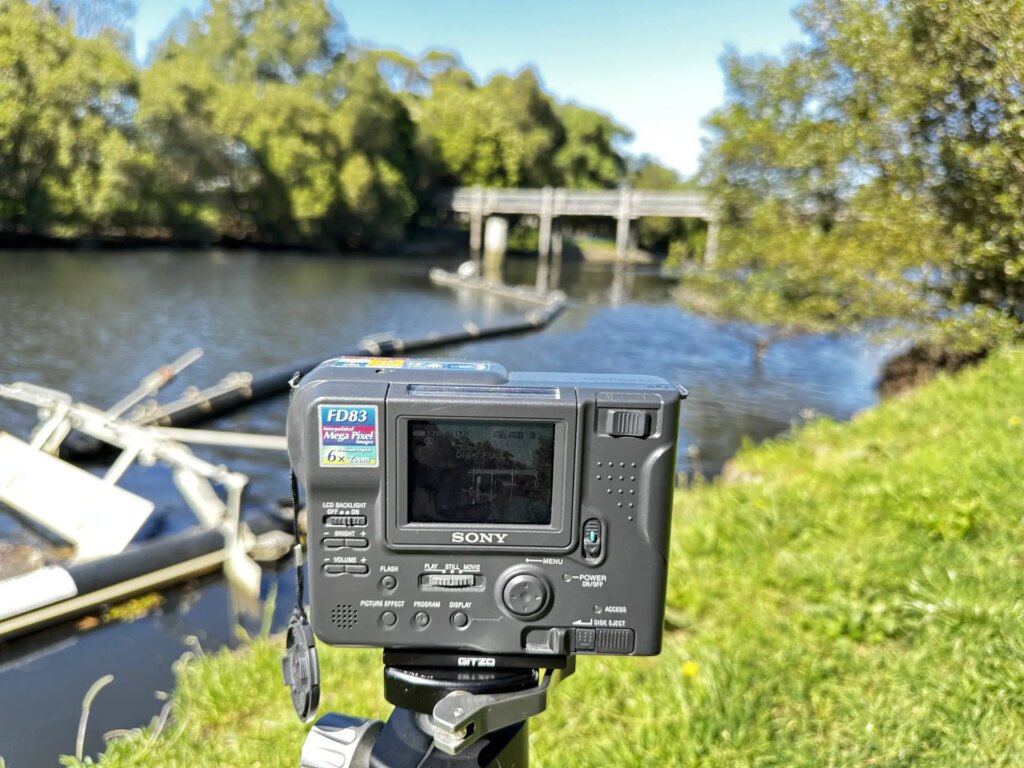
For reasons I don’t understand not all the floppy disks I had could be read or formatted by my camera. And not all files recorded could subsequently be read or saved. This happened for about 1 file per every five disks, which most of the time I could still salvage with patience, but I would completely lose 1 file per 20 disks. Given what I was using the camera for, this could be problematic. In use, the autofocus seemed accurate, and to be honest, the only way to focus. The LCD is so low resolution that I can’t see how you could manually focus accurately. The auto exposure has a shutter speed range of 1/8 to 1/4000 sec. The maximum aperture is f2. The files aren’t malleable and have no head or bottom room. You won’t get recoverable underexposed images.
I was curious as to whether the camera could be used not only for trichromes (any camera with panchromatic monochrome image recording can be used) but for infrared trichromes, and I was pleasantly surprised that it could. Even though the infrared and even red filter layers were underexposed and pretty much unusable on their own, they carried enough colour information to be very effective as a trichrome layer.
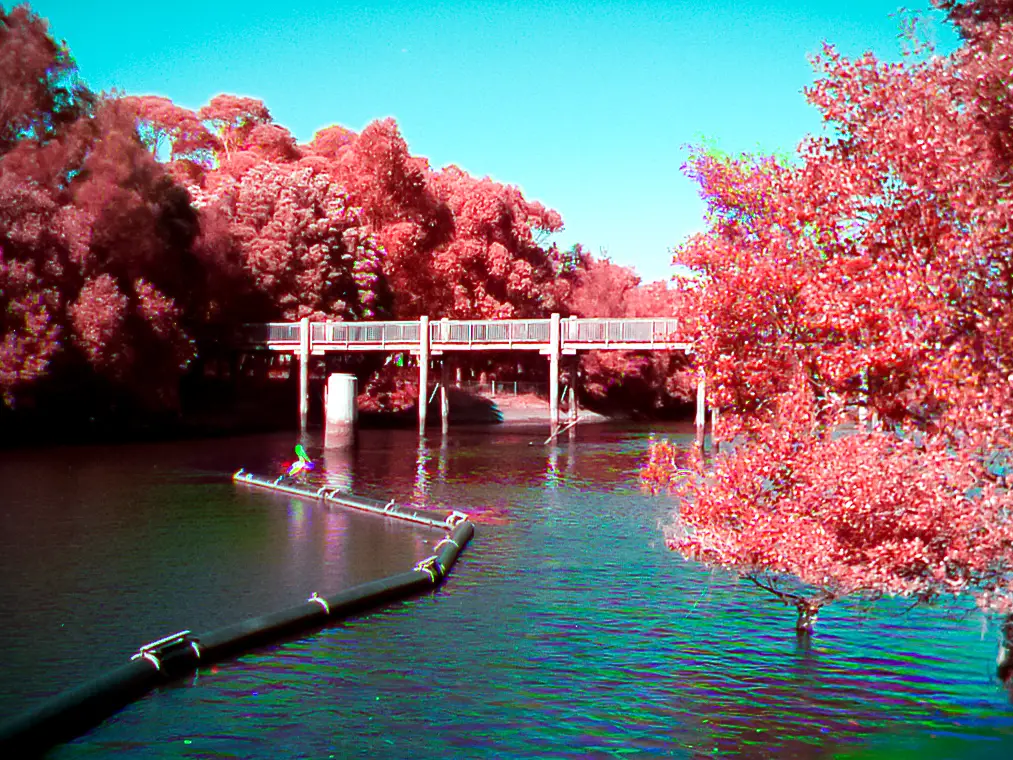
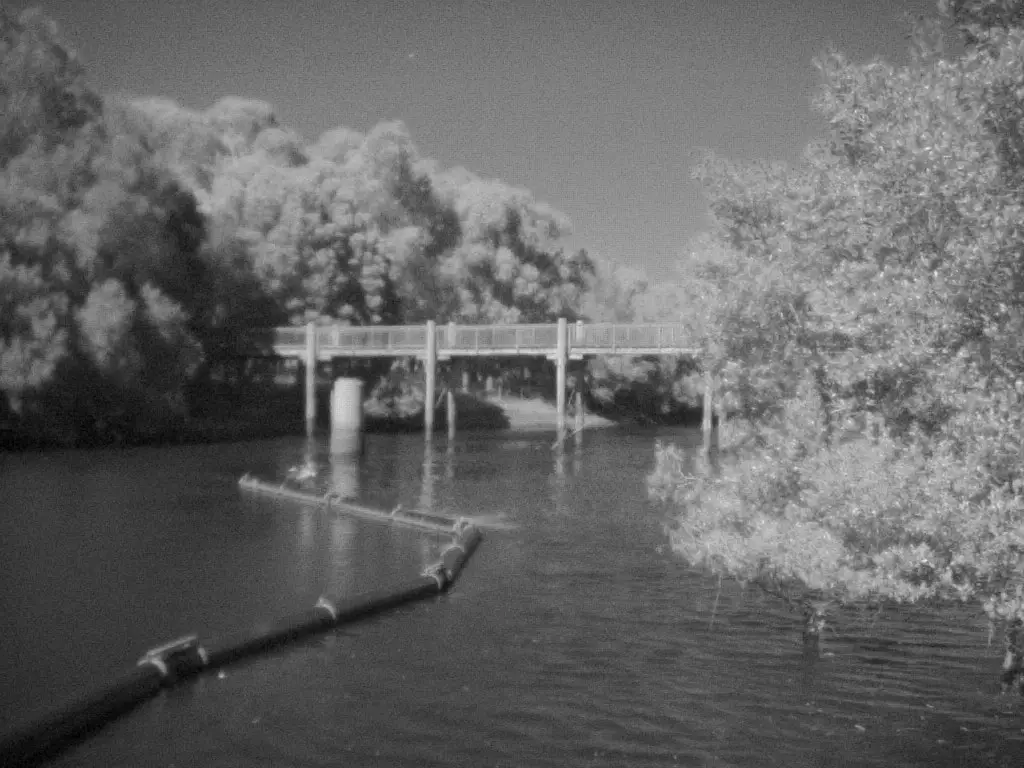
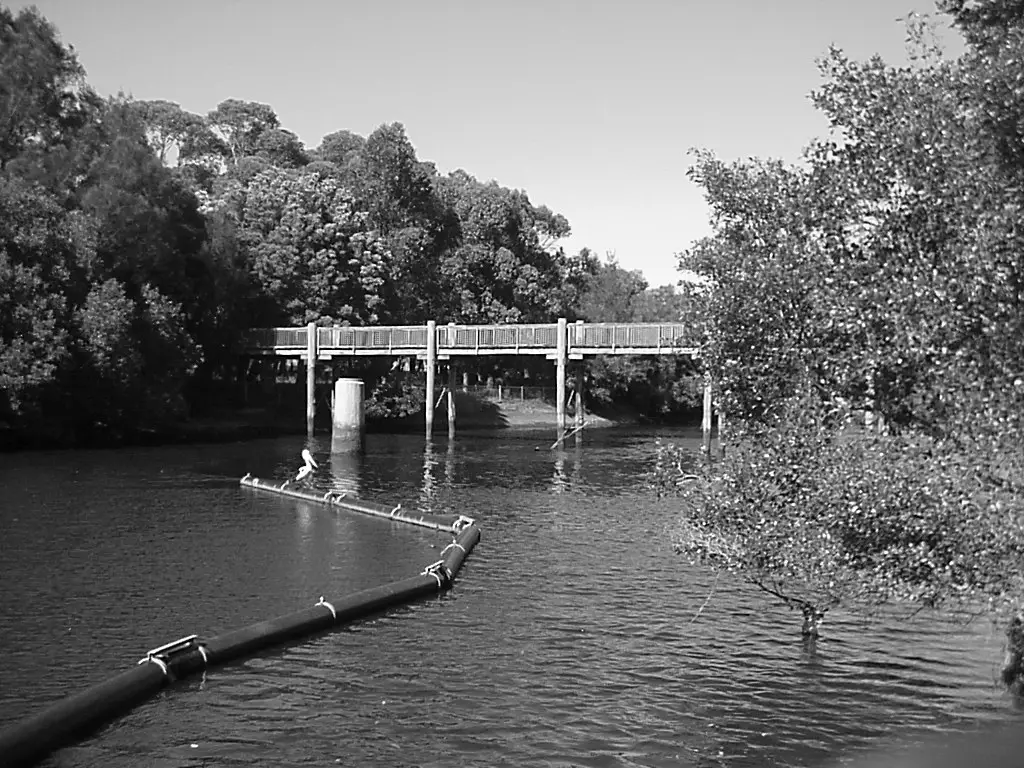
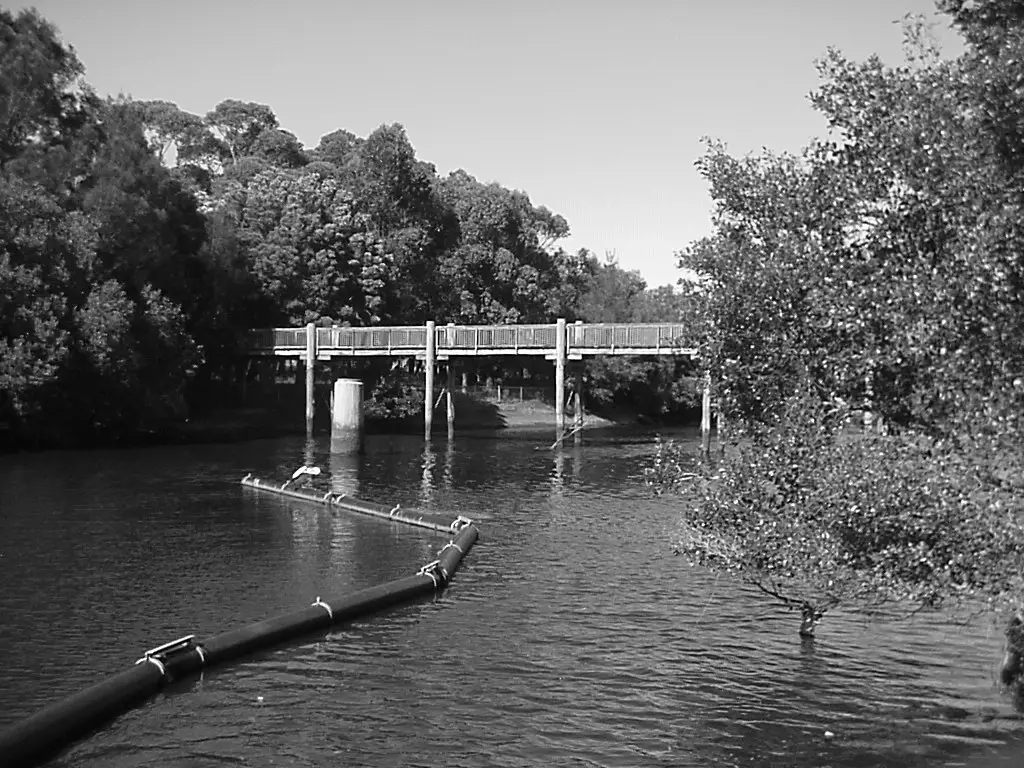
My next step was to try and expand the size and resolution of the photographs by creating photostitched collage images. The biggest issues with the work flow was that some of the collages took up to 22 panels. 12 of the 3.5 inch floppy disks could be needed for 1 final collage image. I didn’t take backup images for the different trichrome layers, so if a file was corrupted or couldn’t be read, that particular panel was a problem…. Despite the limitations, I think the results can be beautiful.
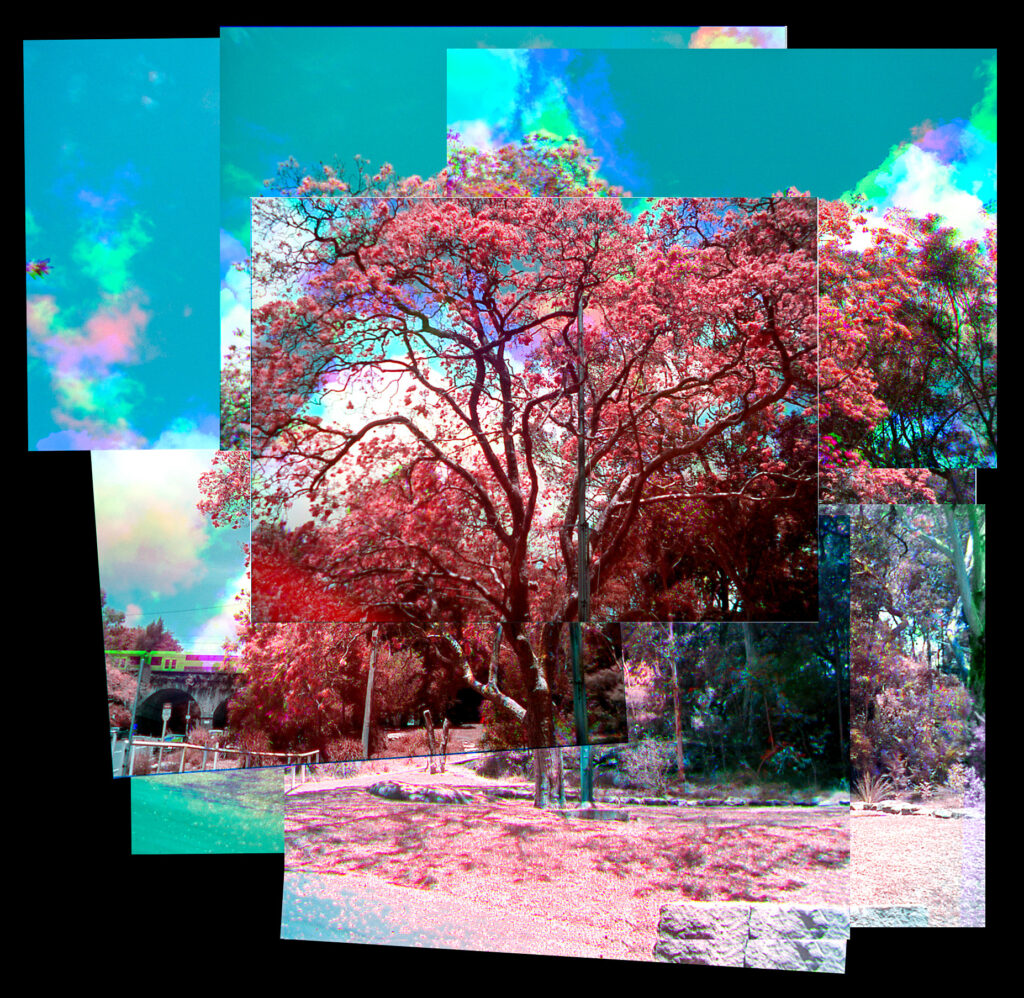
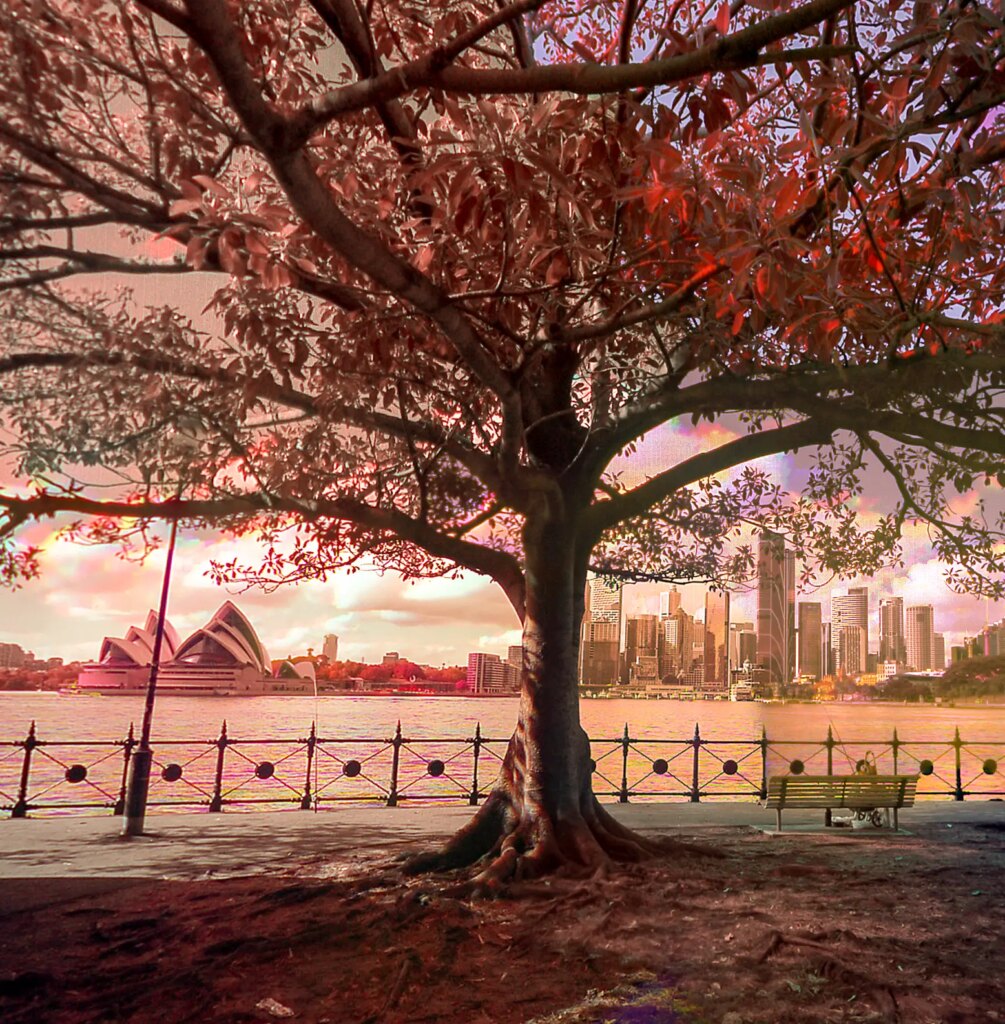
I am surprised at what I can make with tech that old and limited. But then again, that was the whole point of the #ShittyCameraChallenge, to see what the photographer could do, not just the camera.
Morag Perkins
I enjoy an improbable camera, so when the 1990s challenge came around I opted for the most improbable of the lot: a Sony Mavica FD91. This camera is properly, properly bonkers, like Sony took the lens from a high-end camcorder and slapped a floppy disk drive onto it. It has all the possible bells and whistles: 14x optical zoom with a ridiculously good image stabiliser, really good macro capability, plenty of options for manual control … but of course it can only write to floppy disk. It’s not clear why anybody ever thought this camera was a good idea and it probably shouldn’t exist, but somehow it does, and honestly it’s a lot of fun to play with!
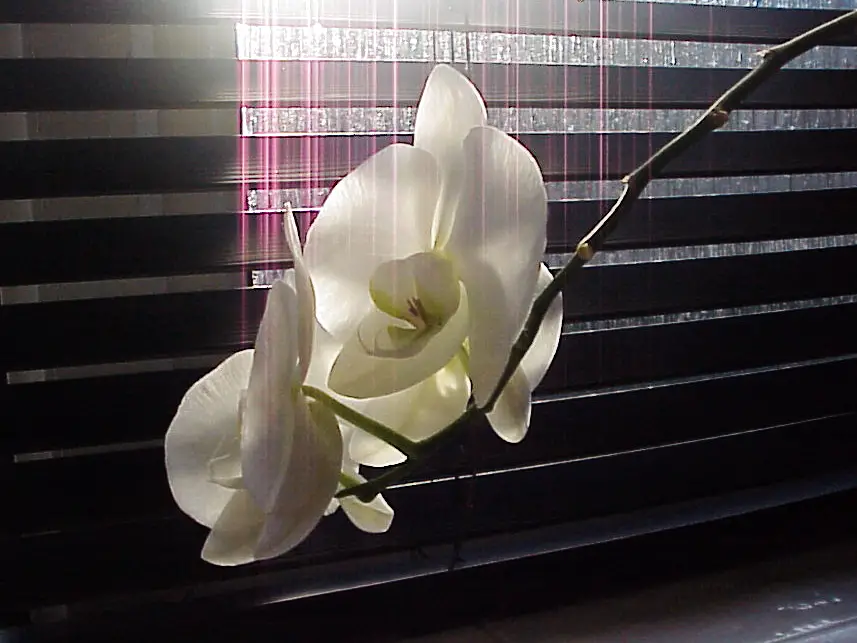
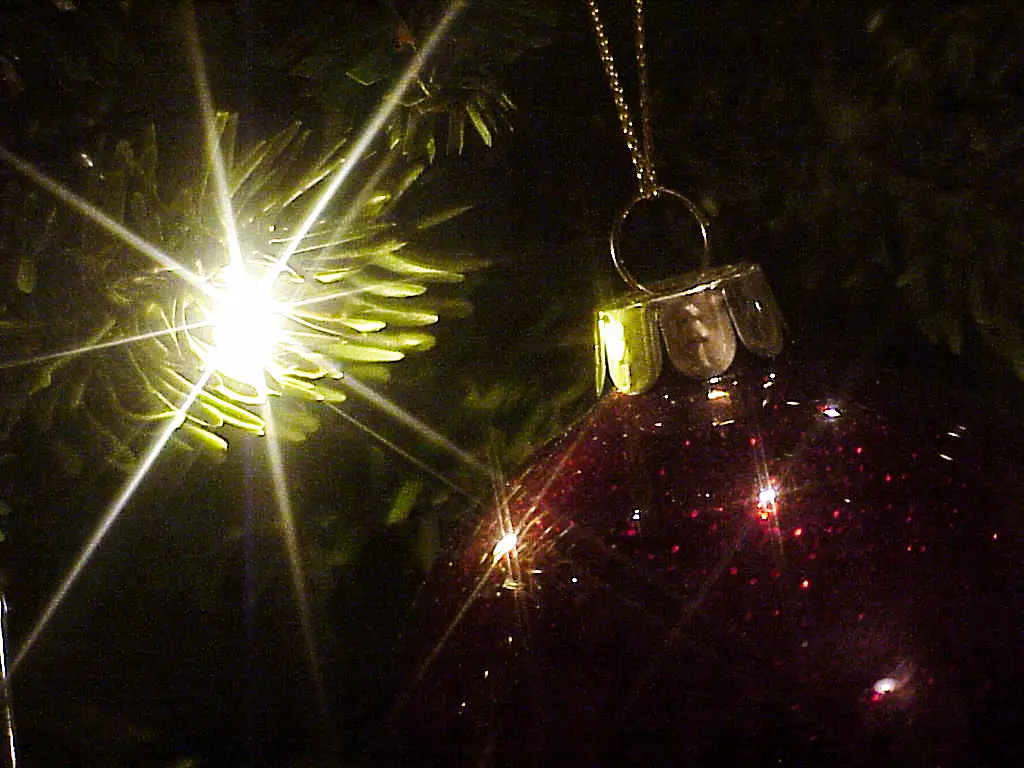
It’s probably something to do with the camcorder lens, but everything shot with this Mavica somehow comes out looking like 1980s VHS (despite it being a camera from 1999) – hold a star filter in front of the lens and honestly you’ve got something from a 1983 TV Christmas special. Other times it generates spectacular bright pink vertical striped lens flare for that vintage low budget sci-fi vibe.
The only time I was able to get something passable from it was by making use of the macro capabilities and manual focus to create stylised landscapes from the inside of a Christmas tree ornament. It took a bit of playing around with a Polaroid Lab and emulsion lifts, but to my great surprise I’ve ended up with some genuine keepers – and nobody would ever guess they started life on a floppy disk! Let’s just keep that between us.
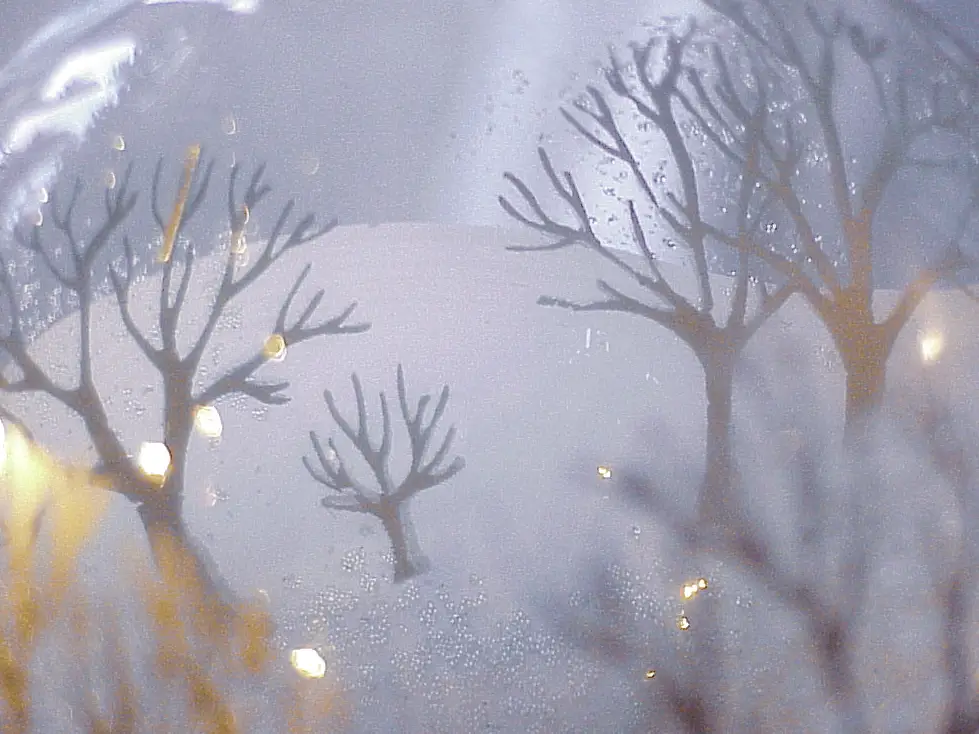
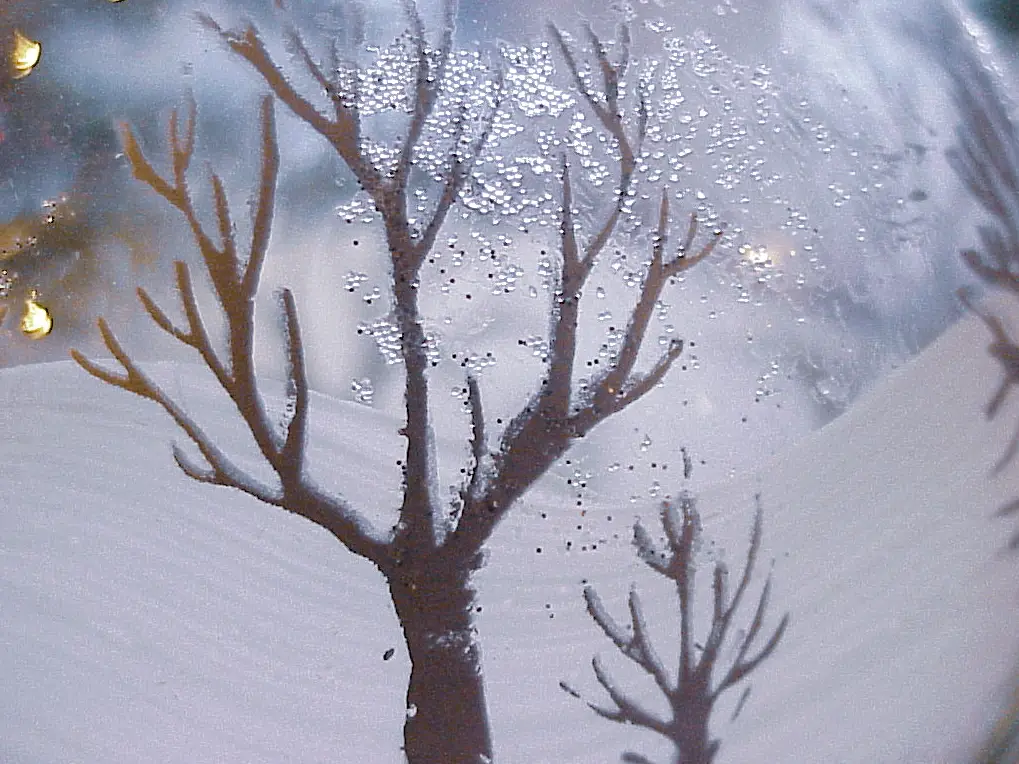
If you’re looking for a bit of over the top retro fun and have something that can read the disks I’d definitely recommend this camera. It’ll certainly get people talking if you take it out and about. Don’t expect anything useful from it though – unless you’re trying to recreate that 80s VHS vibe, in which case buy a crate of floppy disks and knock yourself out.
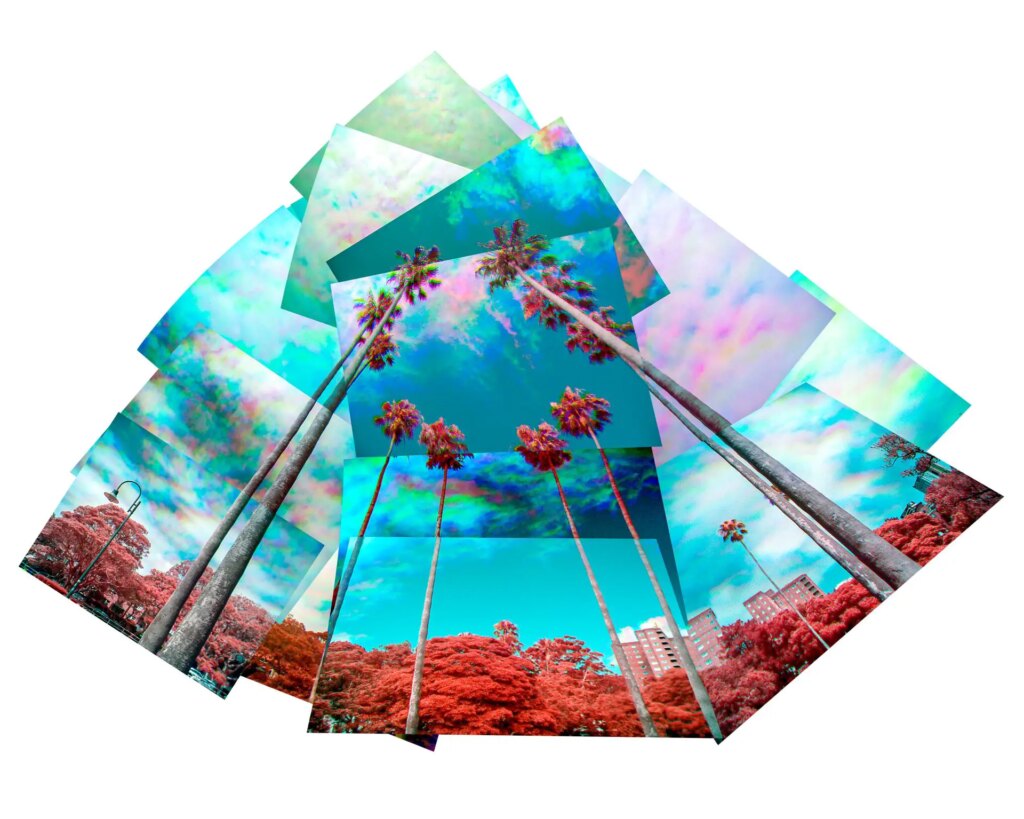
A Final Note
If you thought film was nostalgic, you will certainly get a kick out of a Mavica Floppy Disk camera, though whether you will get a keeper photograph or not, we can’t make any promises …
We are not the only people to have used the Mavica FD for the #ShittyCameraChallenge, and if you want to find the Challenge, all our accounts and images—including from everyone who used a Mavica FD and all the other 1990s cameras besides—can be found on Mastodon on the ShittyCameraChallenge account of Adam James (https://Photog.Social/@ShittyCameraChallenge).
The next Shitty Camera Challenge is starting is starting in June 2023. We hope that you will be able to join us.
Share this post:
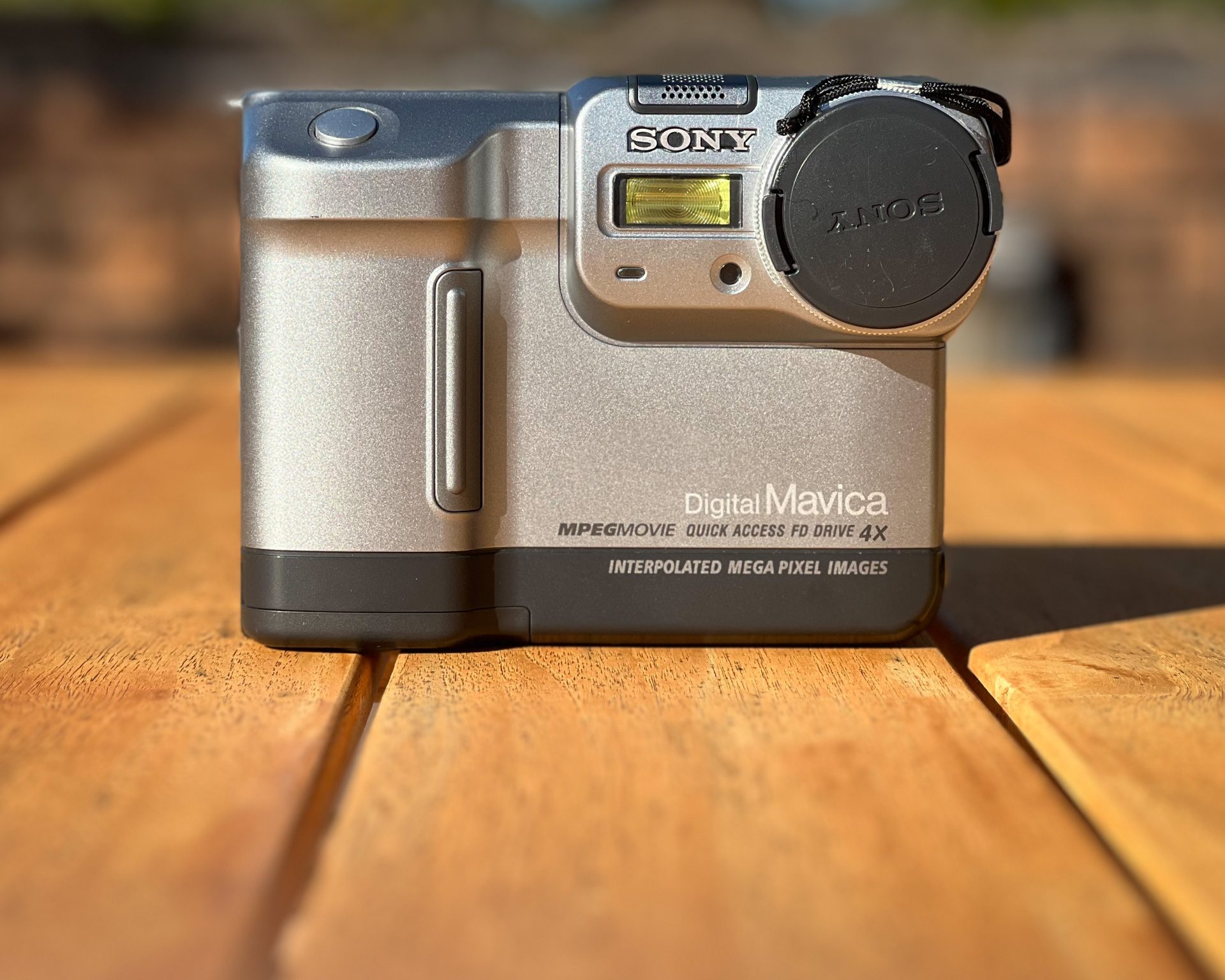








Comments
Bob Janes on Sony Mavica Floppy Disk Camera and the Shitty Camera Challenge
Comment posted: 05/06/2023
Comment posted: 05/06/2023
Peter Bannan on Sony Mavica Floppy Disk Camera and the Shitty Camera Challenge
Comment posted: 05/06/2023
https://www.youtube.com/watch?v=_kU0KnhOas8
Comment posted: 05/06/2023
Lance on Sony Mavica Floppy Disk Camera and the Shitty Camera Challenge
Comment posted: 05/06/2023
Comment posted: 05/06/2023
David Dutchison on Sony Mavica Floppy Disk Camera and the Shitty Camera Challenge
Comment posted: 05/06/2023
Comment posted: 05/06/2023
Daniel on Sony Mavica Floppy Disk Camera and the Shitty Camera Challenge
Comment posted: 05/06/2023
The spirit of experimentation is alive and well here and rewarded by a collection fabulous photos: Morag's surreal collection, Keith's fantastic 5 panel sunrise and Theo's composites and absolutely lovely forest infra red shots and the tree shot with what looks like the Sydney Opera House in the background.
I have had to recalibrate what I thought was a low pixel count, with O.35 surfacing with a capability to actually produce a usable shot.
The first digital camera capable of displacing the ease of use and functional capability of the three decade run of film with a Pentax K1000 was from the 6.3MP Fuji S7000 that produced rich coloured 16x24 inch prints with ease. Now my go-to is the recently serviced 16MP Pentax E30, chosen for versatility, despite a 33MP Pentax K1:in residence.
So, as your gang adequately demonstrate, MPs ain't the determinant of a good photo.
Thank you for the inspiration.
Regards Daniel
Comment posted: 05/06/2023
Gary on Sony Mavica Floppy Disk Camera and the Shitty Camera Challenge
Comment posted: 06/06/2023
Comment posted: 06/06/2023
Marc on Sony Mavica Floppy Disk Camera and the Shitty Camera Challenge
Comment posted: 07/06/2023
Comment posted: 07/06/2023
Scott Gitlin on Sony Mavica Floppy Disk Camera and the Shitty Camera Challenge
Comment posted: 07/06/2023
Comment posted: 07/06/2023